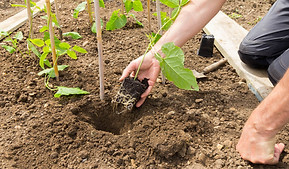
What You Need To
Know About Planting
Trees, Shrubs, and Flowers.
1. Soil Preparation

You had the best of intentions. You were going to get those new nursery plants home and get em in the ground. Well something came up and it took another week to get around to working the soil. Prepare the container or plant location BEFORE you shop for plants. Work the soil and add amendments if necessary. Turn, or replace the soil in a container. Make certain all debris has been removed. Finally, note the hours of direct sun your location will enjoy. Now you're ready !
2. Shop For Plants

A rack of Bargain plants catches your eye outside the drug store. PASS !
A big part of your planting success is starting with fresh, quality plants that are well identified and at their peak of pre-planting development. Always shop a nursery, or garden center with a reputation for consistently offering quality seasonal selections.
3. Choose Plants Carefully

You got that plant home. It's a beauty. Whoops it's too big.
This, and other troubles can come from choosing the wrong plant. Do a little research. Which plant is most likely to do well in the spot where it will call home?
The quickest way to find a plant, any plant, today is . . . Google. Start there with a few of the characteristics you seek most. Standing before the plant table, or consulting your nursery catalog, READ THE LABEL. Does this plant's characteristics meet most, if not all, of your requirements?
4. Don't Settle For Less

You got the plant home ( this includes 6 packs ), popped it out and its root-bound!
Be conscience when shoping plants. Pull a seedling out of a 6 pack, or tap a pot rim, and examine the root ball. If the root ball is a dense mass of roots with no appreciative amount of soil? PASS. If blooms look faded, or leaves look yellow or wilted? PASS! If the pot is VERY heavy ( water logged )? PASS!
5. Tease Out The Roots

Some of your seedlings didn't take as well as others. They lagged behind just a little.
For seedlings to really take off they must get their roots firmly set in the soil you have prepared. To help this, and avoid tearing away any of the delicate roots, remove the seedling from the 6 pack or pot and gently tease the roots out a few at a time with the point of a pencil. These lightly loosened, undamaged roots, will more readily marry with the fresh soil.
6. Suitable Location

In your haste, you put your cucumbers on the shady side of your much taller tomato plants.
So, for nearly all of the growing season the cucumbers suffered. Before you commit plants to soil ( especially in a vegetable garden ) take into account which plants will attain what height.
Then place taller plants in the back when facing the sun, shorter plants in the front.
7. Avoid Air Pockets In Hole

Occasionally you will have a seedling that shrivels up and dies, despite your nurturing.
What may have happened is when the seedling was placed in the planting hole, the root ball did not make contact with the bottom of the hole. In this void, conditions were right for the development of a fungus that attacked and killed the new roots. It is good practice to make the planting hole only as deep as the root ball. Then when the root ball is gentlly pressed into the soil any chance for a pocket is eliminated.
8. Plant Moist In Moist

A common mistake, overlooked too often, is the planting of a healthy moist root ball
in soil that is too dry. If " watering in " is delayed for any reason, the surrounding dry soil can suck the moisture out of the root ball. This condition can be avoided if you remember to plant a moist root ball in moist soil.
9. Fertilizer

Wonder why your new plant isn't performing as you expected?
A little fertilizer at planting time, especially an organic compound to light up that microbial village in your well prepared soil. You want to avoid anything too high in nitrogen
as this could burn tender new roots. Even a few shakes of a slow release polymer encapsulated fertilize can give your young plant a healthy new start.
10. The Gardener's Secret

So you've taken the seedling or transplant from the only home it has ever know and put it gently in a new home. Yet, in spite of your efforts, the seedling or starter plant can suffer from " transplant shock" ! Enter "The gardeners Secret". For gardeners in the know, they count on the extra love SUPERthrive can bring to your new plant at possibly its most critical moment.
